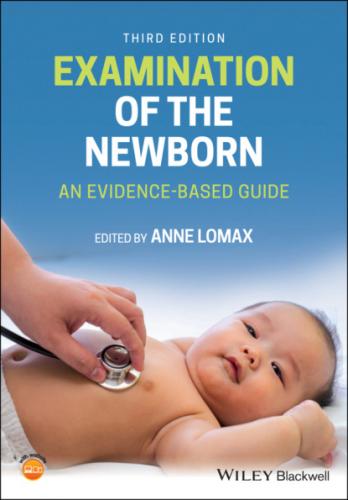Examination of the Newborn. Группа авторов
of location for the newborn examination
The location of the examination is crucial to the quality of the history‐taking discussion with the mother or both parents. The postnatal ward is not a benign environment as the majority are bustling and noisy and not conducive to a history interview. Women may not disclose sensitive information in this environment for fear of being overheard by other patients and health care workers. Disclosure of domestic violence within the high‐impact family relationship can be prohibited due to lack of privacy. Indeed, the presence of the father or other family members may also prevent disclosures of abuse. Patient confidentiality is paramount within the health service. Equally, noise is a distracting feature for both the examiner and the mother. The maternity services of the future may need to revise the existing provision for the examination of the newborn to accommodate an environment that provides privacy and quietness.
Electronic as well as written documentation should acknowledge and reflect that a detailed history has been taken. The use of a history proforma to record the pertinent history themes and significant risk factors can be used. The history proforma can then be placed in the newborn's medical records as evidence of the history‐taking process along with the documentation from the S4N IT system.
Limitations to history taking
This chapter has addressed the elements of the history‐taking assessment to inform the newborn examination. However, there are obstacles that may present and complicate the process (Table 1.8). The two most common problems are time and the environment. These two elements alone can have a significant impact upon the quality and outcome of the history‐taking exercise. The workload pressures endured by many newborn examiners impact upon the time available to perform the examination.
There are other barriers that can compromise the quality of history taking. The questioning technique, manner and general communication skills of the examiner can compromise the level of information imparted by the mother or both parents, who may interpret the line of questioning as invasive, particularly at a sensitive time after childbirth. Conversely, they may have something to hide and fear probing questions. The language barrier has become an increasing problem for many minority groups. All maternity units have access to interpretation services and the Screening Tests for You and Your Baby booklets are now available in a variety of languages. Mothers with hearing disabilities must also be accommodated with a sign language representative.
The evidence base to support the varied facets of the newborn examination may be developing, but NIPE practitioners must continue to acknowledge the importance of an evidence base to underpin and validate practice. Therefore, practitioners must engage with current empirical evidence and embrace the research process. As the body of midwives and neonatal nurses who are trained to conduct the newborn examination is relatively small in comparison to our medical colleagues, it is important that we contribute to the evidence to take practice initiatives forward.
TABLE 1.8 Limitations to effective history taking.
| Time constraints in relation to excessive workload |
| Inappropriate questions |
| Questioning technique, e.g. manner |
| Misrepresentation of facts given about family history |
| Environment in which history is being obtained, e.g. noise |
| Confidentiality |
| Lack of privacy |
| Suppression of disclosure due to partner presence |
| Equality and diversity issues, e.g. language barriers, understanding, |
| cultural diversity, disability, maternal deafness |
| Misinterpretation of information given |
Conclusion
Good history taking has always underpinned effective medical practice. However, the nature of the history profile has changed through the incorporation of government directives and a public policy agenda. The NHS Antenatal and Newborn Screening Programmes can be mapped to the history‐taking process to help guide the NIPE practitioner towards gathering the relevant information. Whilst the maternal obstetric, surgical and medical history remains firmly implicit with the history‐taking process, the psychosocial agenda now reflects the challenges facing families coupled with today's parental lifestyle choices. It can be strongly argued that parental psychosocial influences can impact directly upon not only the newborn period but also childhood and adulthood. The newborn examination provides a platform to address some of these issues so that interventional measures can be implemented at an early stage. This may go some way to help direct parents and safeguard the vulnerable newborn, thereby protecting the health of a future generation. History taking remains an active element of the newborn examination. Without it, the clinical validity of the newborn examination itself could indeed be negligible.
This chapter provides an overview and context of the changing and dynamic nature of history taking as part of the newborn examination. The following websites will provide additional specific information and resources:
